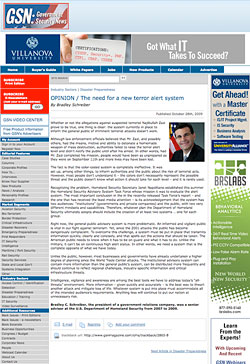October 28, 2009
|
OPINION / The need for a new terror alert system By: Bradley C. Schreiber
Whether or not the allegations against suspected terrorist Najibullah Zazi prove to be true, one thing is clear: the system currently in place to inform the general public of imminent terrorist attacks doesn’t work. Although law enforcement officials believed that Mr. Zazi, and possibly others, had the means, motive and ability to detonate a homemade weapon of mass destruction, authorities failed to raise the terror alert level and didn’t notify the public until after his arrest. In other words, had Mr. Zazi completed his mission, people would have been as unprepared as they were on September 11th and more lives may have been lost. The fact is that the color-coded system is completely ineffective. It was set up, among other things, to inform authorities and the public about the risk of terrorist acts. However, most people don’t understand it – the colors don’t necessarily represent the possible threat and the public doesn’t know what action it should take for each level – and it is rarely used. Recognizing the problem, Homeland Security Secretary Janet Napolitano established this summer the Homeland Security Advisory System Task Force whose mission it was to evaluate the alert system. The most important conclusion in the recently released Task Force’s report – and the one that has received the least media attention – is its acknowledgement that the system has two audiences: “institutions” (governments and private companies) and the public, with two very different mindsets and capabilities. Therefore, whatever plan the Department of Homeland Security ultimately adopts should include the creation of at least two systems … one for each group. Right now, the general public advisory system is more problematic. An informed and vigilant public is vital in our fight against terrorism. Yet, since the 2001 attacks the public has become dangerously complacent. To overcome this challenge, a system must be put in place that transmits information quickly, clearly and concisely, and that spells out the actions that should be taken. The American public needs to know when it has to be on guard and what it has to do. Unlike the military, it can’t be on continuous high alert status. In other words, we need a system that is the complete opposite of what we have today. Unlike the public, however, most businesses and governments have already undertaken a higher degree of planning since the World Trade Center attacks. The institutional advisory system can contain more information than the general public’s system, can be distributed more frequently and should continue to reflect regional challenges, industry-specific information and critical infrastructure threats. Intelligence, vigilance and awareness are among the best tools we have to address today’s “all- threats” environment. More information – given quickly and accurately – is the best way to thwart another attack and mitigate loss of life. Whatever system is put into place must accommodate all of the intended audience’s requirements. Anything less will continue to put our nation at unnecessary risk. Bradley C. Schreiber, the president of a government relations company, was a senior advisor at the U.S. Department of Homeland Security from 2007 to 2009. |



